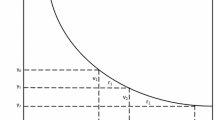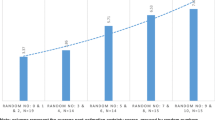Abstract
This study investigates whether or not the scale bias found in contingent valuation (CVM) studies on mortality risk reductions is a result of cognitive constraints among respondents. Scale bias refers to insensitivity and non-near-proportionality of the respondents’ willingness to pay (WTP) to the size of the risk reduction. Two hundred Swedish students participated in an experiment in which their cognitive ability was tested before they took part in a CVM-study asking them about their WTP to reduce bus-mortality risk. The results imply that WTP answers from respondents with a higher cognitive ability are less flawed by scale bias.
Similar content being viewed by others
References
Alberini A, Cropper M, Krupnick A and Simon NB (2004). Does the value of a statistical life vary with the age and health status? Evidence from the USA and Canada. J Environ Econ Manage 48(1): 769–792
Andersson H, Svensson M (2007) Cognitive ability and scale bias in the contingent valuation method. Working paper 2007:1, VTI, Department of Transport Economics, Stockholm, Sweden
Barthomolew DJ (1987). Latent variable models and factor analysis. Oxford University Press, New York, NY, USA
Bateman IJ and Brouwer R (2006). Consistency and construction in stated WTP for health risk reductions: a novel scope-sensitivity test. Resour Energy Econ 28(3): 199–214
Bateman IJ, Carson RT, Day B, Hanemann M, Hanley N, Hett T, Jones-Lee M, Loomes G, Mourato S, Özdemiroḡlu E, Pearce DW, Sugden R and Swanson J (2002). Economic valuation with stated preference techniques: a manual. Edward Elgar, Cheltenham, UK
Benjamin DJ and Shapiro JM (2005). Does cognitive ability reduce psychological bias? . Harvard University, Mimeo
Blumenschein K, Johannesson M, Yokoyama KK and Freeman PR (2001). Hypothetical versus real willingness to pay in the health care sector: results from a field experiment. J Health Econ 20(3): 441–457
Carlsson F, Johansson-Stenman O and Martinsson P (2004). Is transport safety more valuable in the air?. J Risk Uncertainty 28(2): 147–163
Carson RT and Mitchell RC (1995). Sequencing and nesting in contingent valuation surveys. J Environ Econ Manage 28(2): 155–173
Carson RT, Flores NE and Meade NF (2001). Contingent valuation: controversies and evidence. Environ Resour Econ 19(2): 173–210
Clark J and Friesen L (2006). The causes of order effects in contingent valuation surveys: an experimental investigation. University of Canterbury, New Zealand, Mimeo
Corso PS, Hammitt JK and Graham JD (2001). Valuing mortality-risk reduction: using visual aids to improve the validity of contingent valuation. J Risk Uncertainty 23(2): 165–184
Desvousges WH, Reed JF, Dunford RW, Boyle KJ, Hudson SP, Wilson KN (1993) In: Contingent valuation: a critical assessment. Hausman JA (ed) Measuring Natural resource damage with contingent valuation: a test of validity and reliability. The Netherlands: Norht-Holland, Amsterdam, pp 91–159
Diamond PA and Hausman JA (1994). Contingent valuation: is some number better than no number? . J Econ Perspect 8(4): 45–64
Duckworth AL and Seligman ME (2005). Self-discioline outdoes IQ in predicting academic performance of adolescents. Psychol Sci 16(12): 939–944
Frederick S (2005). Cognitive reflection and decision making. J Econ Perspect 19(4): 25–42
Frederick S and Fischhoff B (1998). Scope (In)sensitivity in elicited valuations. J Risk Decision Policy 3(2): 109–123
Green D, Jacowitz KE, Kahneman D and McFadden D (1998). Referendum contingent valuation anchoring and willingness to pay for public goods. Resour Energy Econ 20(2): 85–116
Hammitt JK (2000). Evaluating contingent valuation of environmental health risks: the proportionality test. AERE (Association of Environmental and Resource Economics) Newslett 20(1): 14–19
Hammitt JK and Graham JD (1999). Willingness to pay for health protection: inadequate sensitivity to probability. J Risk Uncertainty 18(1): 33–62
Hammar H and Johansson-Stenman O (2004). The value of risk-free cigarettes – do smokers underestimate the risk? . Health Econ 13(1): 59–71
Hammitt JK and Zhou Y (2006). The economic value of air-pollution-related health risks in China: a contingent valuation study. Environ Resour Econ 33(3): 399–423
Hanley N and Shogren J (2005). Is cost-benefit analysis anomaly proof?. Environ Resour Econ 32(1): 13–34
Harrison GW (2006). Experimental evidence on alternative environmental valuation methods. Environ Resour Econ 34(1): 125–186
Heberlein TA, Wilson MA, Bishop RC and Schaeffer NC (2005). Rethinking the scope test as a criterion for validity in contingent valuation. J Environ Econ Manage 50(1): 1–22
Johnson R (2006). Comment on “Revealing differences in willingness to pay due to the dimensionality of stated choice designs: an initial assessment”. Environ Resour Econ 34(1): 45–50
Jones-Lee MW (1974). The value of changes in the probability of death or injury. J Political Econ 82(4): 835–849
Kahneman D (2003). Maps of bounded rationality: psychology for behavioral economics. Am Econ Rev 93(5): 1449–1475
Kahneman D and Tversky A (1972). Subjective probability: a judgement of representativeness. Cogn Psychol 3(3): 430–454
Kahneman D and Tversky A (1983). Can irrationality be intelligently discussed? . Behav Brain Sci 6: 509–510
Kahneman D, Ritov I and Schkade D (1999). Economic preferences or attitude expressions? An analysis of dollar responses to public issues. J Risk Uncertainty 19(1–3): 203–235
Kahneman D, Slovic P and Tversky A (1982). Judgement under uncertainty: heuristics and biases. Cambridge University Press, New York, NY, USA
Lawley DN and Maxwell AE (1963). Factor analysis as a statistical method. Butterworths, London, UK
NOAA (1993) Report of the NOAA panel on contingent valuation. Federal Register 58, Arrow, K, Solow, R, Portney, P, Leamer, E, Radner, R, and Schuman, H
Persson U, Norinder A, Hjalte K and Gralén K (2001). The value of a statistical life in transport: findings from a new contingent valuation study in Sweden. J Risk Uncertainty 23(2): 121–134
Rabin M (2002). Inference by believers in the law of small numbers. Quart J Econ 117(3): 775–816
SIKA (2007) Vägtrafikskador 2002–2005 (Road traffic injuries 2002–2005). Internet, www.sika-institute.se, 4/26/07
Smith VK (1992). Arbitrary values, good causes and premature verdicts. J Environ Econ Manage 22(1): 71–89
Sugden R (2005). Anomalies and stated preference techniques: a framework for a discussion of coping strategies. Environ Resour Econ 32(1): 1–12
Weinstein MC, Shepard DS and Pliskin JS (1980). The economic value of changing mortality probabilities: a decision-theoretic approach. Quart J Econ 94(2): 373–396
Wolfe R and Johnson S (1995). Personality as a predictor of college performance. Educ Psychol Measure 55: 177–185
Author information
Authors and Affiliations
Corresponding author
Rights and permissions
About this article
Cite this article
Andersson, H., Svensson, M. Cognitive ability and scale bias in the contingent valuation method. Environ Resource Econ 39, 481–495 (2008). https://doi.org/10.1007/s10640-007-9137-0
Received:
Accepted:
Published:
Issue Date:
DOI: https://doi.org/10.1007/s10640-007-9137-0




